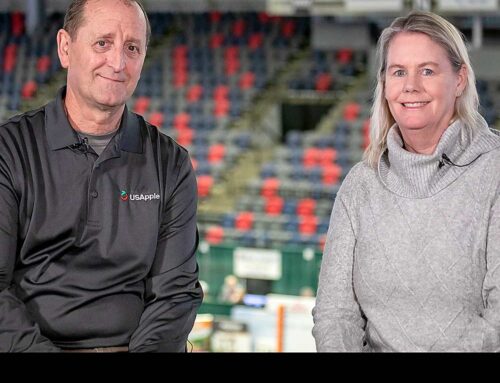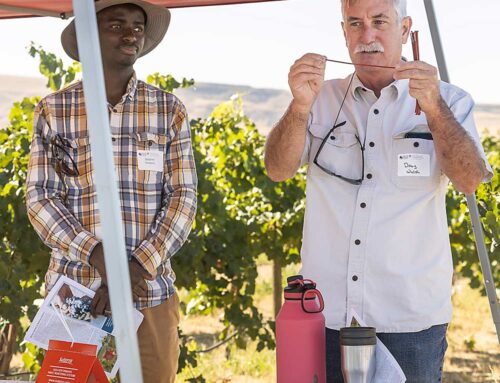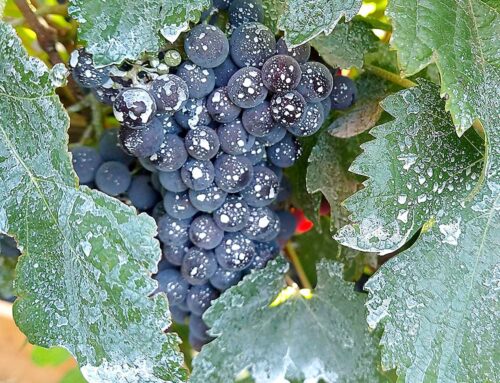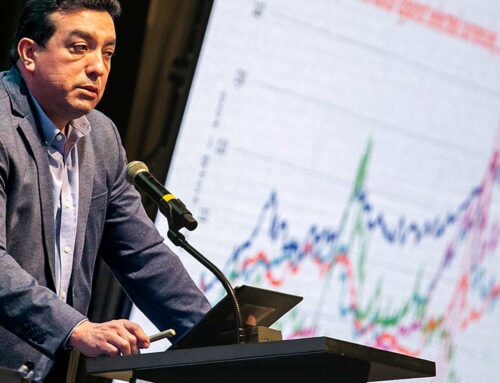
Carlos Lopez credits the beginning farmer loan programs of USDA and Northwest Farm Credit Services’ AgVision for his start in the tree fruit industry ten years ago as a grower. Lopez, 37, standing in his apple orchard on December 12, 2014 in Washington’s Yakima Valley, says he has since partnered with his father and the operation has grown to 190 acres of apples and pears.
(TJ Mullinax/Good fruit Grower)
Elsa Torres, Jose Barajas, Kyle Haugen, and Carlos Lopez are examples of young Washington State growers using agricultural loan programs to help beginning farmers get started.
Various programs are available for beginning growers. For some, it’s a combination of programs that get them started and, for many, the loan program made all the difference in financing their dreams.
The national farm credit cooperative system offers a program for beginning farmers that includes loan fee reductions, and some farm credit services also offer interest-only loans.
The U.S. Department of Agriculture, through its Farm Services Agency, has a beginning farmer loan program for real estate and operating expenses and often partners with local banks or farm credit cooperatives, each sharing part of the loan. States also have “aggie” tax-exempt bonds that can greatly reduce interest rates for beginning farmers, and regional and local banks sometimes have special programs.
Elsa Torres
“Without JumpStart, I wouldn’t be farming,” said Elsa Torres, referring to the new program of Northwest Farm Credit Services. “JumpStart was such a blessing.”
Torres bought 50 acres of wine grapes, apples, pears, and cherries in Zillah last February. She grew up in the tree fruit industry, helping her father who was an orchard manager for 25 years. Her father also had his own small acreage of tree fruit, and Torres, 29, learned everything from installing sprinklers to tractor driving to general orchard management. “Later, my father was able to buy the 40-acre orchard he managed, and I helped build and expand his business,” she said.
“I love farming and wanted to have my own,” said Torres, who has children aged 11 and 9. “My kids love it, too.” B & J Orchard and Vineyard is named after her children.
She combined a JumpStart interest-only loan with USDA’s beginning farmer loan to purchase the land and obtain operating capital.
Torres holds down a full-time job with the State of Washington’s Health and Human Services Department while her husband Juan Diaz manages the new orchard and vineyard. “He’s the one running the orchard while I go to work,” she said, adding that after work and on weekends, they work together in the orchard and vineyard.
Jose Barajas
Jose Barajas became orchard owner in 2003 when he received a loan from USDA to buy 80 acres of apples in west Yakima. The 42-year-old then received an AgVision operating loan from Northwest Farm Credit Services.
He worked for Northwest Farm Credit for about ten years before leaving the cooperative to farm on his own. He initially used a USDA loan to purchase land. In the process of adding to his orchard holdings, Barajas is also buying an orchard directly from a grower who is carrying the loan.
“The Farm Service Agency recommended that I apply for an AgVision loan for my operating loan,” Barajas said, adding that he was reaching the maximum loan limits allowed under USDA’s program.
Barajas has taken advantage of AgVision reimbursements for attending education business conferences and plans to upgrade his computer with the technology reimbursement. “The financial workshops I’ve attended have been really helpful,” he said.
Barajas grew up in agriculture and spent his younger years helping on the family farm. He credits both the USDA and Northwest Farm Credit loan programs for helping him become an orchardist.
Kyle Haugen
Kyle Haugen of Othello didn’t qualify for beginning farmer loans offered through Washington State’s Housing and Financing Commission. But loans through USDA and Northwest Farm Credit gave him the money to purchase 140 acres that currently has 100 acres of blueberries and 10 acres of apples planted.
“Without Farm Credit and USDA, there’s no way I could have bought a farm of this scale,” he said. “You have to have a lot of capital and equity built up to get into farming, and those are the two things I didn’t have.”
Haugen, 29, grew up in Lynden, where his father grows raspberries and has a berry processing plant. After college, he wanted to get into farming on his own and found a blueberry farm in Othello for sale. The property has room for another 20 acres of blueberries in the future.
He used an AgVision loan from Northwest Farm Credit to purchase the land and was approved for an operating loan through USDA.
Through the AgVision program, he was reimbursed for purchase of a new computer and has attended workshops and conferences designed for beginning farmers. He will soon be able to reduce the interest rate on his AgVision loan by three-quarters of a percent through the RateWise component that gives points for attending financial workshops and business management.
Carlos Lopez
Carlos Lopez is another young orchardist who got his start through USDA loans. Lopez, 37, owns 190 acres of apples and pears in partnership with his father in Cowiche. He first had an operating loan through USDA, but when he had an opportunity to expand his orchard acreage, he was encouraged to consider Farm Credit’s AgVision program for his real estate loan.
“AgVision allowed me to expand my orchard,” he said, adding that he became an orchard owner in 2005. He began forming a partnership and consolidating farming equipment and practices with his father in 2009.
Lopez has used AgVision’s reimbursement component to attend business management workshops and learn accounting practices and purchase accounting software for his orchard. •
—————
More than a loan program
AgVision is the name of a program designed to help young, beginning, and small growers access capital and financing. But it’s more than a loan program.
Northwest Farm Credit Services, which covers agricultural producers in Washington, Oregon, Idaho, Montana, and Alaska, has named the program AgVision, though it may be called something else in other Farm Credit districts.
AgVision offers competitive financing rates, with possible loan fee reductions, for things like real estate purchases, operating expenses, equipment purchases, and refinancing existing debt.
The program’s real added value is its education, technology, and mentoring component. AgVision clients are mentored by Farm Credit relationship managers who help them develop solid financial management skills.
Grower clients can receive up to $1,500 in reimbursements for education and technology.
AgVision reimburses young growers up to $500 for attendance (travel, lodging, food, registration) at educational events, including commodity meetings, workshops, and conferences.
Another $500 is reimbursed for attending a Northwest Farm Credit workshop in which a fee is charged. (Most of the 30 to 40 workshops sponsored by Farm Credit are free, but a few are not.)
And finally, up to $500 is reimbursed for purchase of technology, such as a computer, smartphone, tablet, GPS (global positioning system), printer, or other hardware. Software purchases can also be reimbursed.
A new component available to AgVision producers is Farm Credit’s RateWise program that rewards young growers for continuing their business management education with interest rate reductions on new loans or renewed operating loans. Participants earn RateWise credits for attending seminars and workshops that can then be used to reduce interest rates by up to three-quarters of a percent.






Leave A Comment